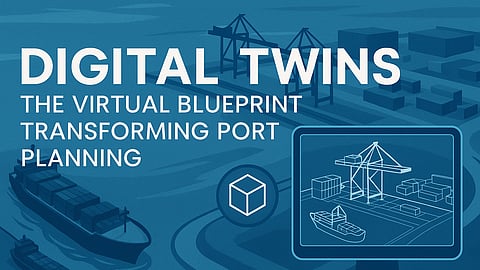Digital Twins: The Virtual Blueprint Transforming Port Planning
In global trade, port efficiency has shifted from being a competitive edge to an operational necessity. Digital twin technology is becoming a game-changer, providing ports with a live, data-rich virtual replica of their infrastructure, operations, and environment.
This enables planners and operators to visualise, simulate, and test changes in a safe, virtual environment before making costly real-world decisions.
Industry experts describe digital twins as a “sandbox” for port operations, allowing the testing of different strategies—whether it’s tackling traffic congestion, optimising berth allocation, or trialling new layouts—without disrupting ongoing work.
Real-Time Simulation for Real-World Impact
By integrating IoT sensors, satellite imagery, and AI-powered analytics, digital twins continuously mirror port activity. Everything from vessel arrivals and cargo handling to weather fluctuations can be modelled in real time.
This allows ports to trial scenarios such as new infrastructure arrangements or seasonal traffic surges before implementation.
Ports like Rotterdam have already demonstrated how these simulations can cut berth waiting times and reduce unnecessary fuel consumption by fine-tuning vessel traffic patterns.
Predicting and Preventing Bottlenecks
Digital twins are not just reactive tools—they are predictive. Using advanced analytics, ports can forecast where equipment, storage, or access points will be needed years ahead of time. \
This long-term visibility prevents bottlenecks, minimises downtime during upgrades, and ensures expansion happens in sync with demand.
The concept revolves around anticipating the chain reactions that occur in complex port environments and making strategic adjustments well before challenges arise.
Sustainability Through Simulation
Beyond operational gains, digital twins are proving vital for environmental stewardship. By modelling vessel speeds, container handling processes, and equipment energy use, ports can identify optimal workflows that cut fuel use and lower emissions.
Singapore, for example, has integrated sustainability metrics into its digital twin systems, allowing planners to test carbon reduction strategies and assess their impact before rolling them out on-site.
The Road Ahead
With AI becoming more advanced and 5G enabling faster and more reliable data exchange, the potential of digital twins is set to grow exponentially. Future iterations could run fully autonomous simulations, constantly adjusting operations for peak efficiency without human intervention.
This evolution positions digital twins not just as a planning tool, but as the foundation for a future where ports operate with unprecedented intelligence, resilience, and sustainability.


